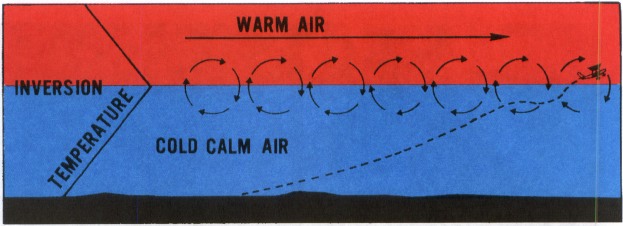Aviation Weather
full text of the classic FAA guide
WIND SHEAR
As discussed in chapter 4, wind shear generates eddies between two wind currents of differing velocities. The differences may be in wind speed, wind direction, or in both. Wind shear may be associated with either a wind shift or a wind speed gradient at any level in the atmosphere. Three conditions are of special interest—(1) wind shear with a low-level temperature inversion, (2) wind shear in a frontal zone, and (3) clear air turbulence (CAT) at high levels associated with a jet stream or strong circulation. High-level clear air turbulence is discussed in detail in chapter 13, “High Altitude Weather.”
WIND SHEAR WITH A LOW-LEVEL TEMPERATURE INVERSION
A temperature inversion forms near the surface on a clear night with calm or light surface wind as discussed in chapter 2. Wind just above the inversion may be relatively strong. As illustrated in figure 86, a wind shear zone develops between the calm and the stronger winds above. Eddies in the shear zone cause airspeed fluctuations as an aircraft climbs or descends through the inversion. An aircraft most likely is either climbing from takeoff or approaching to land when passing through the inversion; therefore, airspeed is slow—only a few knots greater than stall speed. The fluctuation in airspeed can induce a stall precariously close to the ground.

Since surface wind is calm or very light, takeoff or landing can be in any direction. Takeoff may be in the direction of the wind above the inversion. If so, the aircraft encounters a sudden tailwind and a corresponding loss of airspeed when climbing through the inversion. Stall is possible. If approach is into the wind above the inversion, the headwind is suddenly lost when descending through the inversion. Again, a sudden loss in airspeed may induce a stall.
When taking off or landing in calm wind under clear skies within a few hours before or after sunrise, be prepared for a temperature inversion near the ground. You can be relatively certain of a shear zone in the inversion if you know the wind at 2,000 to 4,000 feet is 25 knots or more. Allow a margin of airspeed above normal climb or approach speed to alleviate danger of stall in event of turbulence or sudden change in wind velocity.
WIND SHEAR IN A FRONTAL ZONE
As you have learned in chapter 8, a front can contain many hazards. However, a front can be between two dry stable airmasses and can be devoid of clouds. Even so, wind changes abruptly in the frontal zone and can induce wind shear turbulence. The degree of turbulence depends on the magnitude of the wind shear. When turbulence is expected in a frontal zone, follow turbulence penetration procedures recommended in your aircraft manual.
Table of Contents
Previous Section: Obstructions To Wind Flow
Next Section: Wake Turbulence
A PDF version of this book is available here. You may be able to buy a printed copy of the book from amazon.com.
